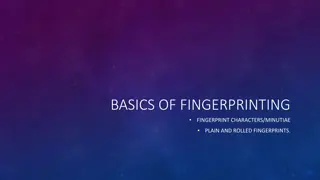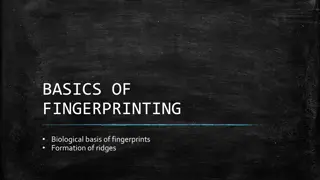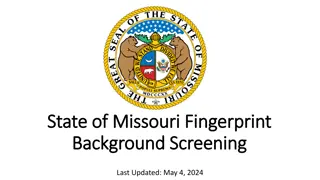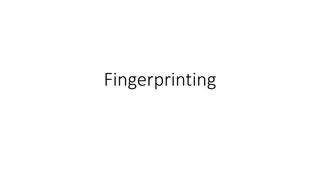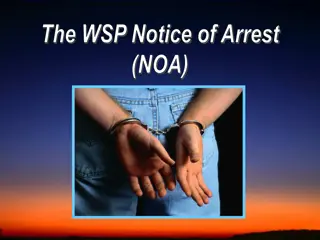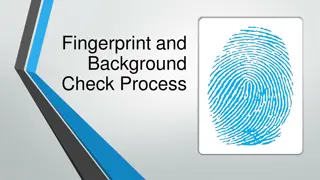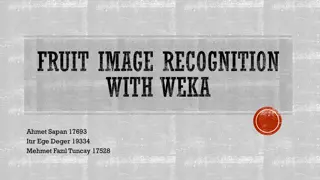Overview of Fingerprint Classification and Cataloguing Methods
Explore the basics of fingerprint classification, including Henry Classification and NCIC Classification systems. Learn about the importance of classification in establishing protocols for searching and comparison. Discover the components of Henry Classification, such as primary, secondary, sub-secondary, and final elements, used in fingerprint cataloguing. Understand the significance of blocking fingerprint cards and primary and secondary classifications based on finger patterns. Gain insights into the classification methods named after Sir Edward Henry and their relevance in forensic investigations.
Download Presentation

Please find below an Image/Link to download the presentation.
The content on the website is provided AS IS for your information and personal use only. It may not be sold, licensed, or shared on other websites without obtaining consent from the author. Download presentation by click this link. If you encounter any issues during the download, it is possible that the publisher has removed the file from their server.
E N D
Presentation Transcript
BASICS OF FINGERPRINTING CLASSIFICATION AND CATALOGUING OF FINGERPRINT RECORD HENRY CLASSIFICATION NCIC CLASSIFICATION Prepared by : Ms. Shruti Rajwar Asst. Professor SoFS, CUTM
WHY CLASSIFICATION IS REQUIRED To establish a set protocol for searching, filing, and comparison purposes. It provides an orderly method to go from the general to the specific.
HENRY CLASSIFICATION Classification system named after Sir Edward Henry. Originally consisted of four parts: primary, secondary, sub secondary, and final. Now includes an FBI (U.S. Federal Bureau of Investigation) extension, which changes the original configuration from four to six categories. ( major and little) After the introduction of technology and various automated fingerprint identification (AFIS) systems, this method has come to be known as the manual method.
CURRENT COMPONENTS OF HENRY Key: The ridge count of the first loop appearing on the card, excluding little fingers. Major: The ridge count or trace value of the thumbs. Primary: The numeric value of each finger containing a whorl pattern. Secondary: Capital letter indicating the pattern of index fingers. Sub secondary: Values of counts and traces of loops and whorls of the index, middle, and ring fingers. Final: Ridge count of loops appearing on the little fingers.
The known fingerprint card gives us the necessary information. Information is inserted onto the card aka blocking the card. Blocking the card consists of inserting the appropriate information consisting of numbers, letters, and symbols in the appropriate places on the card. layout and position of the fingers on the fingerprint card :
PRIMARY Numeric value of the finger where a whorl appears. Whatever finger the whorl appears on, that finger assumes the given value. Upon adding up the numbers, add 1 to the value. Even number fingers, 2, 4, 6, 8, and 10 are registered in numerator and Odd number fingers 1, 3, 5, 7, and 9 are registered in denominator. Numeric chart for primary If all fingers have ,primary classification will be 32 over 32. If no whorls appear on the card, primary classification will be 1 over 1.
SECONDARY Indicates the pattern type of the index fingers and is always indicated by a capital letter. A = arch T = tented arch R = radial loop W = whorl U = ulnar loop Registered as right hand over left hand on the classification line. Placed immediately to the right of the primary classification.
SUBSECONDARY Grouping of ridge count and/or whorl trace symbols for the index, middle, and ring fingerprints appearing on the card and it is indicated by letter. Right hand is indicated above the line, the left hand is indicated below the line. Placed to the immediate right of the secondary division on the card.
MAJOR Ridge count or ridge trace value of the thumbs, right hand over left hand. Designated immediately to the left of the primary. If there is an A or T in the thumbs, there will be no major classification. Whorl trace values will be indicated by inner (I), meet (M), or outer (O). Loop counts must be converted into small (S), medium (M), or large (L).
Always count the left thumb first. Based on the ridge count of the left thumb print, the right thumb designation can be determined based on the conversion chart. Left thumb conversion (For ridge counts) : 1 to 11 small (S) 12 to 16 medium (M) 17+ large (L) For Right thumb : Refer the chart. If a whorl appears in the left thumb print, use the smaller conversion chart to the right thumb.
FINAL Ridge count of a loop appearing in the little fingers. Right little finger is examined first to see the presence of loop. If there is no loop pattern in the right little finger, then the left little finger is examined. If neither the right nor the left little fingers possess a loop, there will be no final. Final can not consist of both fingers In large whorl sections, whorls can also be counted but this is rare.
KEY Ridge count of the first loop appearing on the card excluding the little fingers. The designation for the key is always indicated above the line farthest to the left on the classification.
REFERENCING Referencing is an alternate choice that is displayed on the classification to indicate that although the classification may be indicated a certain way, it may also be something else. For example, a pattern may be indicated as a loop with a ridge count of three, but the pattern may also be a tented arch. Or one may not be certain of a ridge count or trace value. Factors making referencing necessary: Variation in individual judgment and eyesight The amount of ink and/or pressure used Differences in width of the rolled impression Worn ridges caused by disease, age, or occupation Amputations, temporary or permanent scars, and bandaged fingers Crippled hands
CLASSIFICATION OF SCARRED PATTERNS When the following cannot be determined Give a. Pattern type and value_________Class of opposite finger b. Pattern only_________________Pattern of opposite finger with actual value and reference c. Count or Trace value__________Probable with reference d. Opposite fingers scarred_______Meet whorls
CLASSIFICATION OF AMPUTATED FINGER Missing fingers Class One_______________Same as opposite with all references Two or more_________Same as opposite with no references Opposite___________Meet whorls Fingers missing at birth are treated as amputations If all ten fingers are missing________ M 32 W MMM (meet whorls) If both hands are amputated, take footprints. (FBI maintains footprint files) If there is a partially amputated tip, it is classed as it appears and is referenced to the opposite finger
CLASSIFY THE FOLLOWING AC. TO MODIFIED HENRY CLASSIFICATION WITH FBI EXTENSION
NCIC CLASSIFICATION National Crime Information Center Computerized system based in Washington, D.C. Uses twenty characters on a line. Each finger is represented by two characters.
IAFIS CLASSIFICATION Integrated Automated Fingerprint Identification System. Two characters per finger.






